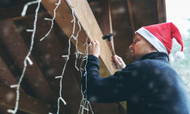How Do Christmas Lights Really Work?
30th Dec 2019
Christmas lights – they’re such a familiar sight in the winter. But have you ever thought to yourself, “How do Christmas lights work?” Here we’ll seek to answer that question.
The Basics
To understand how Christmas lights work, it helps to know first how a basic circuit functions. In a simple setup with only one LED light, electricity runs from a battery’s positive end through a wire to the anode of the lightbulb. The anode is the long protrusion on the bottom of the bulb through which current can enter, and it’s positively charged. The current then passes through the bulb and goes into the negatively charged cathode (shorter leg) and out through another wire that leads back to the battery’s negative end. This completes the loop, or circuit, so that the electrical current can move tiny particles called electrons and electron holes which then collide in the LED and cause it to glow.
It’s important to note that each LED light has a resistor that limits the current that goes inside and powers its glow. The reason it needs this component is because a small change in the voltage from a power source could hugely change the current that runs into the LED, which could potentially burn it out. To protect it from varying voltages, the resistor is put in place because it has a linear relationship between voltage and current. This means a small change in voltage will remain a small change in current. Once the electricity goes through it, it will no longer have the possibility of blowing out of proportion in the LED and causing damage.
Multiple Lights
Now that you grasp how to activate a single LED lightbulb, you might wonder how a circuit is created with multiple lightbulbs together. There are two setups that can work in this circumstance.
Lights in Series
The first is to put the lights in series. This means that each lightbulb is connected to next one in a straight path. To illustrate this, think of a circuit with two lights. Here, the positive end of the battery would connect to the first bulb, another wire would pass between the first and second bulbs, then a third wire would connect the second bulb to the negative end of the battery.
Lights in Parallel
Another way you could turn on more than one light is to have your bulbs in parallel. In this arrangement, each lightbulb has its own individual complete circuit. If you wanted to turn on two lightbulbs in this configuration, you would have two wires connected to the positive end of the battery, each of which goes to one of the lightbulbs. Both lightbulbs would have a wire going back to the negative side of the battery, giving it contact with two wires as well.
Christmas Lights
Now which method is employed for Christmas lights? They exist in strings, so it would stand to reason that they would connect in series, and in fact, they do. However, you may wonder what would happen if any one of the bulbs were to go out. Would it break the circuit and cause the whole line to go dark?
The answer is actually no. Conveniently, when an LED goes out, they mostly short circuit. This means that a bulb that no longer works becomes a path of low resistance through which electricity can continue to travel. If an LED string does stop working altogether, the reason is often found in other places, namely physical wire breaks or blown fuses.
Now you know what’s behind the illumination of your Christmas lights. Even though LEDs are long-lasting and energy-efficient, they can break down as the years go by. If you’re looking to replace some of your old lights this year, Action Lighting can fulfill your needs. From mini lights to party tent lights, we’re sure you’ll find just what you want.


